Participants
Principal Investigator/Project Director:
Helmut Kaiser, University of Missouri
Co-PIs:
Haskell Taub, University of Missouri
Roger Pynn, Indiana University
Flora Meilleur, North Carolina State University
Arnold Burger, Fisk University
Trainees:
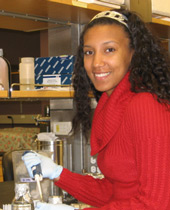 Virginia Smith, Indiana University
Virginia Smith, Indiana University
I am a fourth-year biochemistry graduate student working in Dr. Bogdan Dragnea’s lab at Indiana University-Bloomington. My project concerns elucidating the physical principles behind cargo packaging and release by a plant virus, the brome mosaic virus (BMV). To track the changes the RNA undergoes both inside and outside the virus capsid, we induce folding with divalent cations and polyamines that neutralize the negative phosphate backbone of fluorescently labeled RNA. My goal is to develop a method of probing compression/decompression transitions based upon fluorescence that would be amenable to in situ single-molecule microscopy.
 Annette Bodenheimer, North Carolina State University
Annette Bodenheimer, North Carolina State University
Currently I am working on solving structures of Cel7a and cytochrome p450 using X-ray and neutron crystallography with Dr. Flora Meilleur. Cel7a, also known as cellobiohydrolase I (CBHI), is responsible for cleaving crystalline cellulose into cellobiose and is the first enzymatic reaction in the process of converting biomass into ethanol. Cytochrome p450 is a protein that is used to oxidize organic compounds. We hope that a neutron structure will allow us to understand fully the hydrogen transfer that occurs during the oxidation reaction.
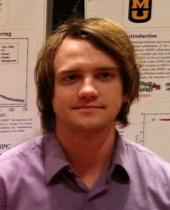 Zack Buck, University of Missouri
Zack Buck, University of Missouri
My name is Zack Buck, and I am a Ph.D. student in the Department of Physics and Astronomy at the University of Missouri. Neutron scattering is a sample characterization method used in a vast number of scientific and engineering disciplines. The technique’s capabilities are virtually endless and range from studying the dynamics of folding proteins to witnessing the structural changes within a material due to cycles of hydrogen adsorption and desorption. My research focuses on understanding the structure and dynamics of water molecules near the interfaces of model cell membranes. Specifically, I investigate how the different lipid compositions used to make up the membrane influence the physical properties of the nearby water molecules. Our group has had the opportunity to perform quasielastic neutron scattering measurements at national laboratories such as Oak Ridge National Lab, TN and at the NIST Center for Neutron Research, MD; but we have also conducted neutron diffraction measurements right here in Columbia, MO at the University of Missouri Research Reactor (MURR). Through a combination of experiments performed on a variety of neutron scattering instrumentation, it is possible to understand how water behaves near the interface of a model membrane. My goal is to increase the complexity of our model membrane systems towards a more physiological state by inserting a simple protein into the membrane, melittin. I hope to be able to see how the presence of the melittin influences the behavior of the water associated with the membrane. I would like to thank my advisor, Dr. Haskell Taub, and my MURR supervisor, Dr. Helmut Kaiser, for their constant support and guidance.
- The figure shows a single-supported bilayer membrane (no inserted proteins) sitting on top of a very thin layer of water with a silicon-oxide substrate underneath. By using neutron reflectivity, we can understand the composition and thicknesses of these molecular layers.
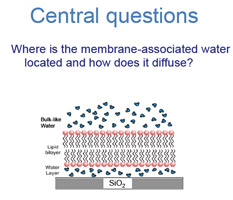
As suggested by E. T. Castellana and P. S. Cremer, Surf. Sci. Rep. 61, 429 (2006).
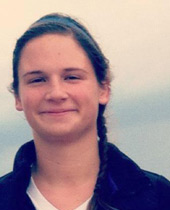 Emily Armbruster, University of Missouri
Emily Armbruster, University of Missouri
Ribosomes are the macromolecular factories that manufacture all proteins for the cell. By translating information from an mRNA template. the ribosome synthesizes chains of amino acids. During this translation, the ribosome contorts and interacts with other cellular components to produce a properly folded and appropriately located protein. I am a second year biochemistry graduate student who is interested in using biophysical techniques such as small-angle neutron scattering (SANS) to elucidate the dynamics of these operations.
 Drew Menke, University of Missouri
Drew Menke, University of Missouri
I am currently a Ph.D. candidate and Research Assistant in the Biochemistry Department working under Dr. Peter Cornish. Our research group is interested in the ribosome and how it moves in order to synthesize protein. Our lab primarily uses a fluorescence technique called Fluorescence Resonance Energy Transfer (FRET) to study the ribosome and its motion. This technique allows for real time detection of dynamics and monitoring of structural changes. However, because of limitations of this technique and advantages inherent to neutron scattering, we are interested in using neutrons to address problems that are inaccessible to FRET. The complementary nature of these two techniques in combination with classical biochemistry methods provide a promising route to elucidate further the ribosome’s mechanism of protein synthesis.
 Zenia Norman, University of Missouri
Zenia Norman, University of Missouri
I am a graduate student in the Bioengineering Department working under the direction of Dr. Peter Cornish. Our lab is interested in studying the dynamics of the ribosome—an organelle responsible for protein synthesis. Protein synthesis is one of the crucial processes in living cells. During the process of protein synthesis, the ribosome is known to rotate between two conformational states—a nonrotated state and a rotated state. Recently our lab was able to discover a third state—the hyperrotated state. We had an opportunity to perform Small Angle Neutron Scattering (SANS) at NIST and also Oak Ridge National Laboratory as an investigative tool to verify the third conformational state of the ribosome. SANS is a great tool to study the ribosome and other biological complexes because it provides shape and size information. Because neutrons scatter differently from hydrogen and deuterium, we were able to use neutron scattering to our advantage by using the method of contrast variation—a powerful technique to match out parts of a biological complex. Therefore, SANS can help produce models of the ribosome, which can help us understand more about how the ribosome functions. I would like to thank my advisor Dr. Peter Cornish, Dr. Haskell Taub, and Dr. Tabbetha Dobbins for their constant support and guidance.
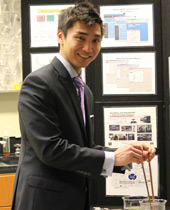 Feng (Tom) Zhang, University of Missouri
Feng (Tom) Zhang, University of Missouri
I am currently a 3rd year graduate student working on a Ph.D. in Mechanical Engineering with Dr. Hongbin (Bill) Ma and Dr. Robert Winholtz as my advisors. I’ve interned/co-oped at multiple firms such as Northrop Grumman, Chatsworth Products, and Heil Environmental. My current research topic involves the use of surface treatments such as hydrophilic hierarchical cupric oxide nanostructures and hydrophobic plasma polymers in oscillating heat pipes (OHP) to alter the two-phase fluid motion for enhanced performance. An experiment at NIST in December 2013 was performed and a number of interesting visualization capabilities were observed. Eventually a hybrid hydrophilic and hydrophobic surface treated OHP will be produced with the hope of controlling the fluid motion.
- Fabricated bottom half of the flat plate oscillating heat pipes with the internal channels.

 Matt McCune, University of Missouri
Matt McCune, University of Missouri
My name is Matt McCune, and I joined Integrative Graduate Education and Research Traineeship (IGERT) Program as a fourth-year Physics Ph.D. student at the University of Missouri. As a research assistant in the Theoretical and Computational Biological Physics Group of Dr. Ioan Kosztin, I employ computational methods and analytical modeling to better understand how biological systems behave at micro- and mesoscopic levels.
As an IGERT trainee I will collaborate with Dr. Taub’s experimental group that uses quasielastic neutron scattering to study the dynamics of water and lipids in single-supported hydrated lipid bilayer systems. I will model and investigate the dynamics of a similar system by employing molecular dynamics (MD) simulations and analysis tools from statistical mechanics.
 Matt Bryan, Indiana University
Matt Bryan, Indiana University
I am a graduate student in the Indiana University physics department working in the Sokol group. My current work focuses on neutron scattering studies of liquid helium in mesoporous confinement. We employ adsorption isotherms and x-ray diffraction techniques for characterization. Our neutron scattering studies fall into three categories: small angle scattering, deep inelastic scattering, and weak inelastic scattering. Small angle scattering is used to study the structure of helium confined in ~5 nm orderd pores. A recent experiment showed a new structure in He3-He4 mixtures, incommensurate to the pore lattice, at temperatures many times higher than the typical phase separation temperature in bulk liquid. Our current experiments are looking to learn more about this new structure. Deep inelastic scattering is used to measure the momentum distribution of helium. It has been used to measure the Bose-Einstein condensate fraction in liquid helium at low temperatures. However, the condensate in confinement is an open question that has not been the subject of much study. Weakly inelastic scattering measurements focus on the phonon-roton excitation curve that reflects the liquid structure and superfluid dynamic behavior.
 James Torres, University of Missouri
James Torres, University of Missouri
I am currently pursuing a Ph.D. in Physics as a first-year graduate student at the University of Missouri. The IGERT program for neutron scattering has allowed my passion for materials science and condensed matter to develop further. Under the supervision of Dr. Robert Winholtz and Dr. Haskell Taub, I am beginning a project to study the dynamics of water near metal surfaces, specifically those in copper Oscillating Heat Pipes (OHPs). OHPs offer one of the more promising avenues to increase the thermal conduction efficiency in removing excess heat from electronic devices including computers and optical instruments such as lasers. The heat pipes use a fluid, such as water, that oscillates between heat source and a sink to achieve their high performance. My research will involve using quasielastic neutron scattering to probe the diffusion of water at the molecular level near copper surfaces similar to those found in OHPs. Our aim is to understand how the performance of OHPs depends on the microscopic interaction of water with their interior surfaces.
 Joe Schaeperkoetter, University of Missouri
Joe Schaeperkoetter, University of Missouri
I am a graduate student in the Department of Physics and Astronomy at the University of Missouri. I started my graduate research studies in Fall of 2010, studying the structure of porous materials with applications towards hydrogen gas storage. I used a technique of taking nitrogen adsorption isotherms, whereby closely monitoring how much nitrogen is adsorbed to the surface of a material you can determine things like the size of the pores and the surface area of that material. I also began researching the chemical functionalization of the material surface; by changing the surface chemistry, we hoped to induce a stronger attraction with the hydrogen gas. I closely studied the elemental and local chemistries of the materials with a technique called X-ray Photoelectron Spectroscopy. Becoming an IGERT trainee in fall of 2014, I am now working on construction of a gas adsorption instrument to be used at University of Missouri Research Reactor that will allow the user to controllably change the amount of hydrogen loaded into a material while simultaneously taking neutron diffraction measurements. I will investigate material response to an adsorbed film (material breathing) as well as an examination of hydrogen densities within a porous material. I wish to thank my adviser, Dr. Carlos Wexler, as well Dr. Peter Pfeifer, Dr. Helmut Kaiser, and Dr. Haskell Taub for their support and guidance.
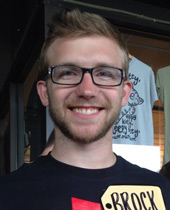 Brock Summers, University of Missouri
Brock Summers, University of Missouri
I am a second-year graduate student in the Department of Physics at the University of Missouri, working with my advisor, Dr. Deepak Singh, in the superconductivity and magnetism lab conducting experimental research. The focus of my research is to explore the spin (magnetic) caloritronics in topographical nanofabricated devices. The device I am currently fabricating uses a top-down approach with the self-assembly properties of diblock copolymers to create a system of locally hexagonal periodic array of nanoscale Co dots encapsulated by polycrystalline thin Cu film. This new material has shown interesting properties such as the coexistence of giant thermal hysteresis and anomalous magnetoresistance behavior (quasi-periodic oscillation vs. H field). These experimental observations lead to new exploration of the possibility of magnetic caloritronics. I will perform detailed electrical measurements to explore the possible Inverse Spin Hall Effect as well as the thermal-electric-magnetic properties of this new material. I will also perform detail neutron scattering measurements at the NIST Center for Neutron Research and Oak Ridge National Laboratory to understand the role of magnetic and structural properties in the ensuing thermoelectric and thermomagnetic phenomena. Recent theoretical reports suggest that the efficiency of the spin caloritronics device can be tuned by exploiting the collective excitation of magnetic ions. A large periodic array of magnetic dots automatically forms a magnon system, as each magnetic dot exhibits a giant magnetic moment. Therefore, the collective excitations of correlated giant spins provide the necessary ingredient to test recent theoretical hypotheses.
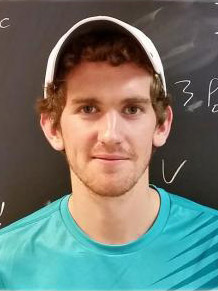 Alessandro Mazza, University of Missouri
Alessandro Mazza, University of Missouri
I am a graduate student at the University of Missouri in the Department of Physics and Astronomy. I began my graduate work at Mizzou in the fall of 2014 and became an IGERT trainee in January 2015. Shortly after, I began my work under the advising of Professor Paul Miceli in the field of experimental condensed matter physics. Our specific research interest is to understand the mechanism of ferromagnetism in hydrogen-doped graphene (graphone). Room-temperature ferromagnetism in graphone has been predicted theoretically and observed experimentally, but the role of hydrogen and the origin of the magnetism in these studies has been unresolved. Neutron scattering provides the unique capabilities of being sensitive to isotopes (and light atoms) such as hydrogen/deuterium and having a magnetic moment which can be utilized to probe the magnetic profile of materials. By use of polarized neutron reflectivity, a powerful tool in the investigation of magnetic thin films, we plan to address the questions pertaining to the magnetic and hydrogen profile in graphone.
 Chip Smith, University of Missouri
Chip Smith, University of Missouri
I am a 5th year graduate student in the Department of Chemistry at the University of Missouri – Columbia. I have been working in Dr. Gary A. Baker’s lab now for the last three years. The focus of my dissertation research has been developing new gel materials from bacterial cellulose and ionic liquids and understanding the many uses these new materials can be used as well as the physical properties of these gels. I also work in the areas of nanoparticle synthesis, catalysis, and sensing. Currently we are focusing on the development of systems that alter or stabilize the structure of proteins to enhance catalytic and pseudo catalytic reactions. I joined the Integrative Graduate Education and Research Traineeship (IGERT) the Spring 2016. We are looking to use neutron scattering in our cellulose and ionic liquid gels (ionogels) to better understand the dynamics of the ionic liquid inside the cellulose. These ionogels have opened up a new type of ionogel material that has a plethora of uses that we are trying to unravel through understanding the underlying dynamics and confinement of the ionic liquid.
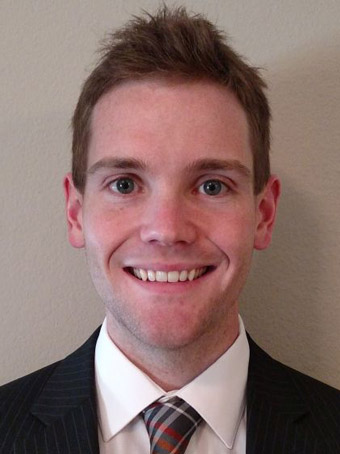 Travis Tumlin, University of Missouri
Travis Tumlin, University of Missouri
I am currently a first-year graduate student in the Mechanical & Aerospace Engineering department at the University of Missouri under the guidance of Dr. Jian Lin in the Advanced Materials Group. My work is on the development of low-dimensional materials for high-performance electronics. Next-generation electronic materials, such as graphene and molybdenum disulfide, can’t compete with current silicon technologies due to low-throughput synthesis of small single-crystals. Our group is focused on better understanding the growth mechanisms for the development of wafer-scale single-crystals with controllable doping. Specifically, I am working to understand the relationship between edge dehydrogenation in two-dimensional (2D) materials and the surrounding oxygen environment. It has been suggested that during high temperature growth, small amounts of oxygen aid in the synthesis of large, single crystal domains. Since neutron scattering is sensitive to low atomic number materials such as hydrogen, we hope to utilize this information in better understanding the mechanism associated with edge growth in 2D materials. This work will also help determine the point at which oxygen content is detrimental to growth in the form of attacking grain boundaries and surface oxidation.
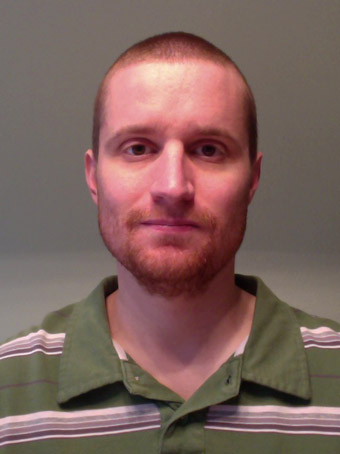 Christopher Carr, University of Missouri St. Louis
Christopher Carr, University of Missouri St. Louis
I am a graduate student in the joint Missouri University of Science and Technology and University of Missouri - St. Louis Ph.D. program working under the guidance of Dr. Eric Majzoub. Our research group uses a combined computational/experimental approach to study and design materials for energy storage and conversion. My current research is focused on the use of complex metal hydrides as a reversible hydrogen storage material for proton exchange membrane fuel cells for vehicular transportation. In particular I am investigating the confinement effects of metal hydrides in highly ordered nanoporous carbon scaffolds produced using self-assembly techniques. The release of hydrogen from metal hydrides is often complicated, involving many possible reaction pathways and mass transport of hydrogen containing species during the decomposition process. These processes may be directly influenced by the hydride/scaffold interfacial energies and designed to improve both the kinetics and thermodynamic properties of the confined hydride. The IGERT traineeship will allow us to conduct neutron scattering experiments that will be vital to the determination of the mobile hydrogen species present in our materials.
